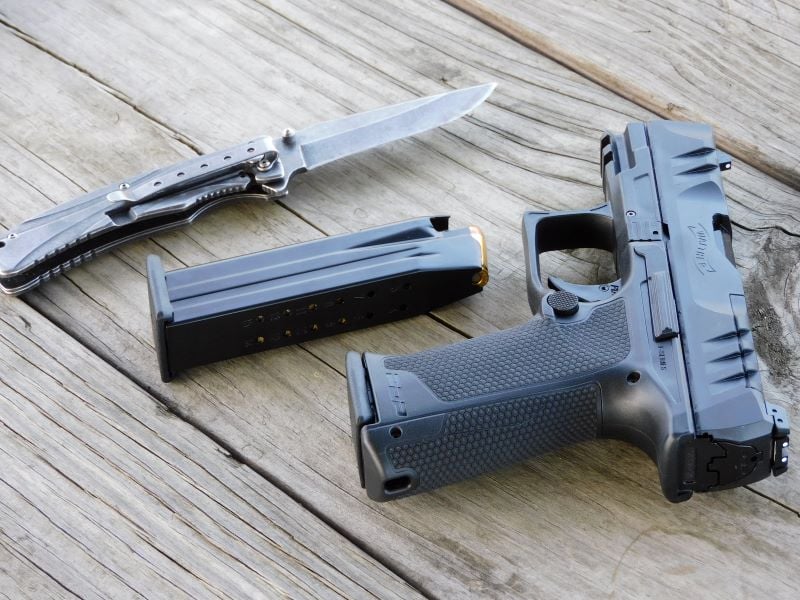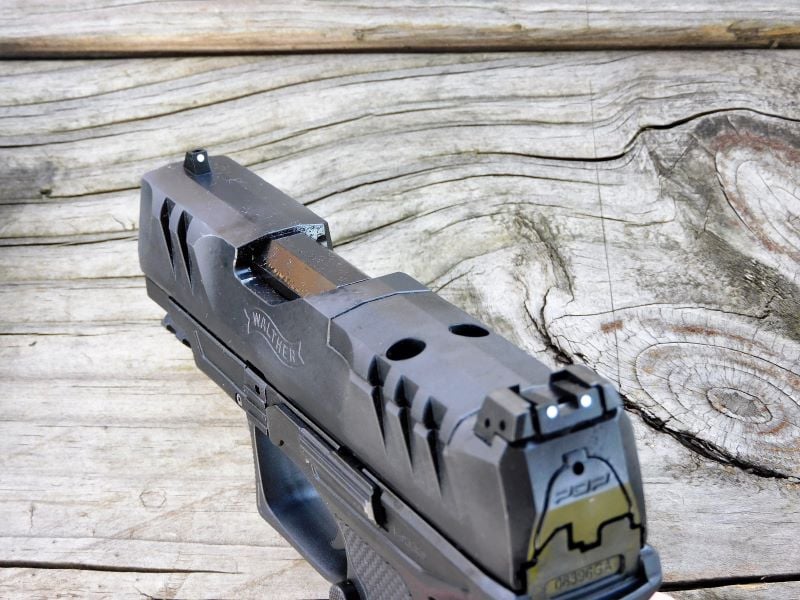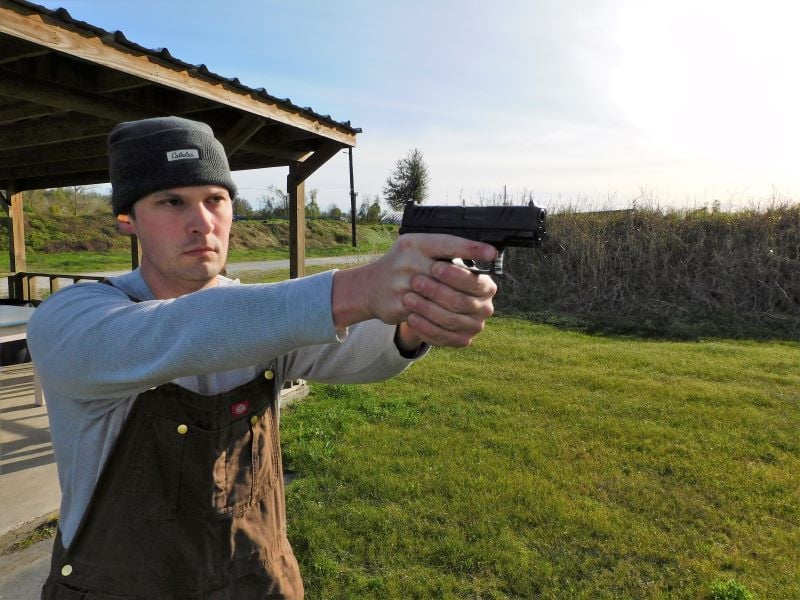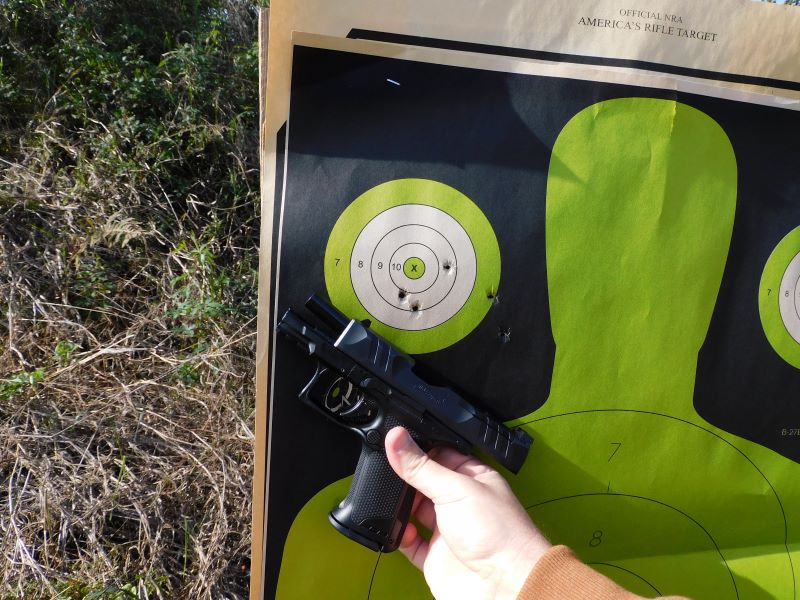In 2021, Walther announced the retirement of the much-beloved model PPQ and introduced the Performance Duty Pistol or PDP as its replacement. When I heard the news, I joked about another victory for the flannel-wearing, craft-brew-drinking millennial men that are flocking to handguns with newfangled red dot optics. In 2022, Walther introduced a PDP targeting smaller-handed shooters in the PDP F-Series. The promotional material suggests a perfect pistol for the ladies with an easy-to-rack slide, a reduced grip circumference, and a shorter trigger reach than the stock PDP. As it turns out, the PDP F is great, even without an optic and it is awesome in the bigger hands as well.

Truth be told, I was curious about learning my way around red dots even though I would be hard-pressed to give up iron sights. Red-dot compatible pistols run the gamut in size, quality, and price. Red dots are a natural addition to competition 2011s but such guns aren’t practical nor priced accordingly for most people to carry or buy.
Luckily there are plenty of polymer-framed carry and duty pistols out there that are now red-dot ready. I briefly considered the Taurus G3 and Sig 365-380, but the quality of the former was suspect and the size of the latter was a bit too small. The Beretta APX and Glock 48 are quality, affordable, moderately priced options, but I ultimately decided on the Walther PDP F.
Walther PDP F Features
Operationally, the Walther PDP F series is a conventional striker-fired polymer-framed pistol. Like most of its competitors, the PDP F feeds from a conventional double-stack magazine and uses a Picatinny rail over the dustcover for mounting a flashlight. At the time of this writing, it is only available in 9mm Luger but comes with either a 3.5-inch or 4-inch barrel. My particular example has the former barrel length.
The PDP F incorporated a number of improvements that shooters have come to expect including a squared-off trigger guard and ambidextrous slide release, as well as forward and rearward cocking serrations on the slide. On other pistols, these appointments seem like cheap afterthoughts but Walther took greater care. The square and stippling on the trigger guard are more aggressive. The slide release is a single-milled piece of steel instead of bent sheet metal. The slide serrations, what Walther calls their Superterrain serrations, are few, but deep and angular.

If you are used to a straight grip angle of a Glock, the grip of the Walther will look a bit strange, tapering up to the beavertail while flaring out on both sides at the butt. It does lack the backstrap bulge seen in other Walther pistols, however. The front of the butt takes on a C-shape, not unlike some old American flintlocks, anchoring the pinky in place. The grip stippling lacks the harsh sandpaper feel of the S&W M&P but is clingier than Glock dots.
The magazine release button is interchangeable to either the left or right side to pair the ambidextrous slide stop. The PDP’s trigger mimics Glock’s safe-action trigger, with an inner shoe that must be depressed in order for the pistol to fire. But that is where the similarity ends. Their Performance Duty Trigger, as Walther calls it, broke clean on my Lyman trigger scale at 4 lbs. 6 oz. From a resting position, there is only a few millimeters of travel before the trigger hits a wall and then breaks. The trigger return spring is stout and a slight let-off brings the trigger back to a short, brisk reset.

The PDP is designed with a micro red-dot optic in mind, but it does not come with an optics plate. Instead, there is a voucher with the factory box to obtain the appropriate optics plate. Given how many optics are on the market, this might be better than sending optics plates that will go into the trash bin. Straight out of the box, the Walther wears a set of traditional three-dot iron sights.
The PDP F-Series disassembles like most striker-fired pistols available today. With the pistol dry-fired, all you have to do is draw the slide back a touch, push down the takedown lever inside the trigger guard, and draw the slide off the frame. Internally, the PDP is a typical Browning-style locked breech design. This 3.5-inch model uses a dual recoil spring, while the 4-inch uses only one. Both are captive by a polymer guide rod.

Walther designed the PDP to be modular, allowing you to change slides, barrels, and grip frames at will. The compact and full-sized barrels and slides can be intermixed as their four and five-inch barreled models use the same recoil spring. However, the 3.5-inch model will need a new recoil spring to upgrade in barrel length. In any event, the compact PDP F-Series are compatible with eighteen-shot full-sized PDP magazines as well as the two factory fifteen-shot magazines that come with the pistol.
To round out the package, the factory box contains the requisite owner’s manual, lock, one grip adapter, and a magazine loader.
On The Range
After a quick cleaning, I put the Walther PDP F-Series through a few range sessions with 300 rounds downrange. Although this is not a high volume of shooting, I was able to shoot some drills and do some accuracy testing to render a holistic judgment.
I started with a magazine loaded with CCI Blaser 115 grain FMJ target loads and bullseye targets at ten yards to see where the sights were hitting. Out of the box, the sights were zeroed perfectly. I could reliably put five rounds into a four-inch pattern at that distance before I warmed up to the trigger.

I then set up some bullseye targets at fifteen yards and shot from a rest to see how well the pistol shot and cycled with different loads including:
Hornady Critical Defense Lite 100 grain FTX 3.0 inch
Remington HTP 115 grain JHP 4.4 inch
Sig Sauer V-Crown 124 grain JHP 3.25 inch
Sig Sauer V-Crown 147 grain JHP 3.4 inch
CCI Blaser 115 grain FMJ 4.2 inch
TulAmmo 115 grain FMJ steel-case 4.8 inch
Of this limited selection, the Hornady Critical Defense Lite gave the best group and, surprisingly it shot to the point of aim despite being light-for-caliber. It also had the least amount of felt recoil, although none of these loads were unpleasant.
Off the bench, I took my remaining ammunition, mostly CCI and TulAmmo 115 grainers, and shot a 1/2 D28 steel target at 30 yards. As long as I was able to get a gross alignment of the sights and a proper trigger press, hitting was no problem. The addition of a red dot would only make quick distance shooting easier; but as it comes out of the box, the PDP F does quite well.

I ran the PDP F as set up for a right-handed shooter out of the box, even though I am a lefty. I didn’t find anything wanting when operating and shooting the pistol. The straighter grip angle of the PDP made the pistol’s sights line up on target when aiming offhand, but the contours of the grip itself were hand-filling and there was no empty space for the pistol to recoil into.
The reload was more of a mixed bag. I found it just as easy to hit the magazine release button with my left index finger, rather than change the button to the other side. The magazines fly free, even when empty and I didn’t have to reach up with my other hand to yank magazines out of the magazine well. On some smaller gripped guns, the meat of my hand would stop magazines from clearing easily. The Walther PDP F-Series has no problem here.
The slide stop is big and easy to hit to chamber a new round from a fresh magazine. But when firing the pistol, my bigger thumbs tended to ride over the top of the slide stop and keep the pistol from locking open on the last shot. This isn’t the fault of the pistol but my own training. I shoot mostly revolvers and I use a thumbs-over grip. Most folks aren’t going to have this problem. In the event of a click instead of a bang, I knew I was out and changing magazines was a breeze.
Racking the slide didn’t take much effort. Walther does claim that the PDP F has an easier-to-rack slide, but I believe this is due mostly to the aggressive serrations that give plenty of purchase, rather than a significant reduction in spring weight.
Parting Shots
Although my meaty hands sometimes got in the way of flawless performance, I left the range happy with the Walther PDP F-Series. There were no failures to fire or to feed and it digested everything from steel-case range trash to premium hollow-point loads. Even without a red dot, the PDP is an excellent shooter. The iron sights are zeroed and squared away. The grip is molded for a commanding, but fatiguing hold. The buttons and switches can be tweaked for wrong-handed people like me but can be left alone for the other 90% of you. The factory trigger alone is probably worth the price of admission.
The PDP and its trimmer F-Series line have a long way to go to commanding the staying power of its predecessor, the PPQ, but it deserves a long, hard look if you are in the market for a personal defense or duty pistol with modern appointments that can make a good shooter even better.

